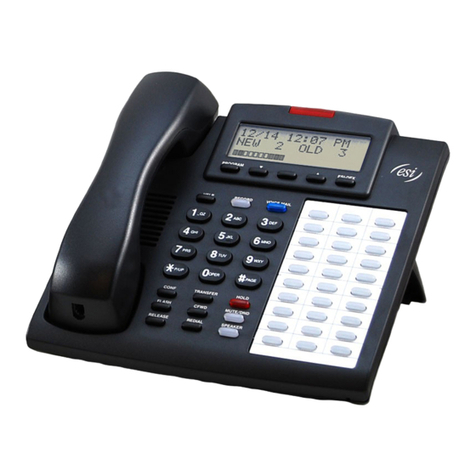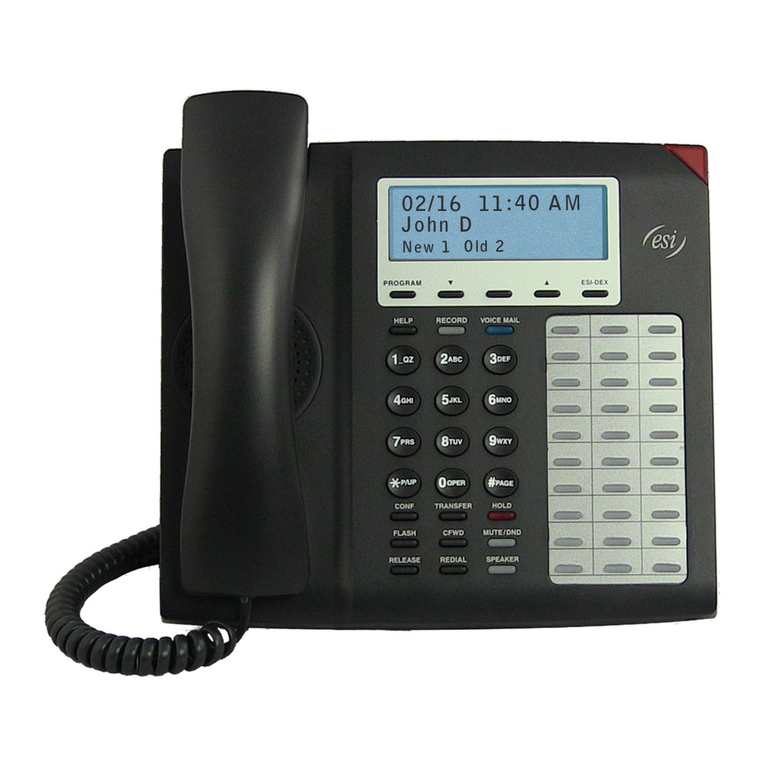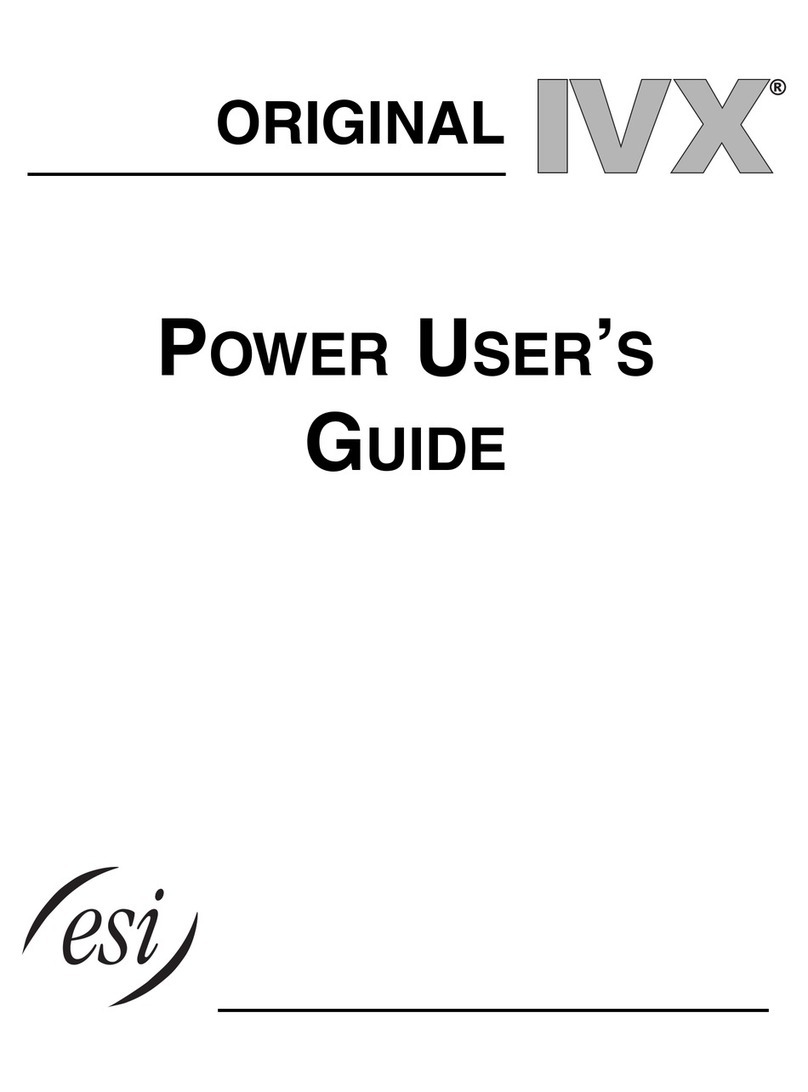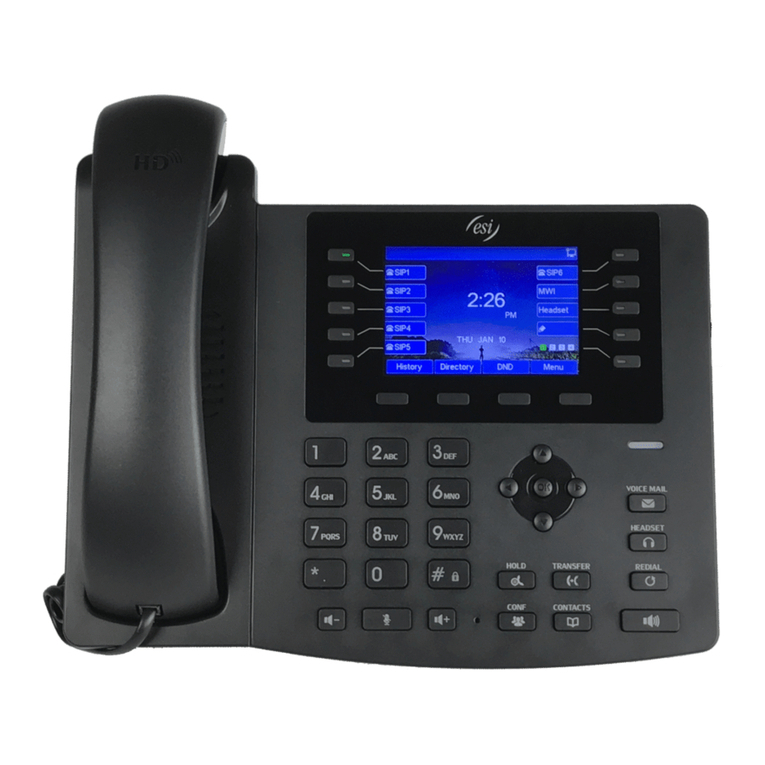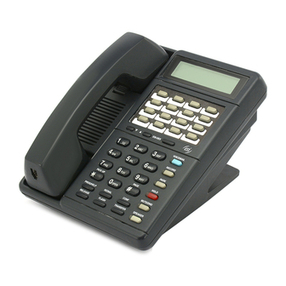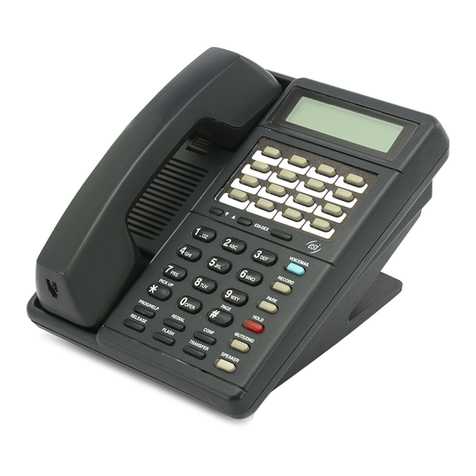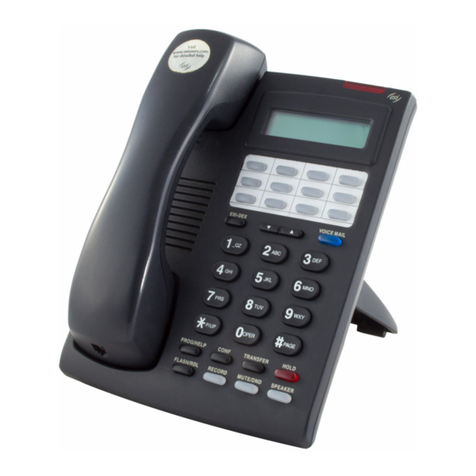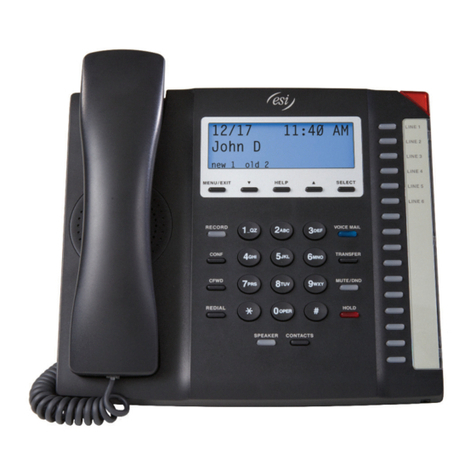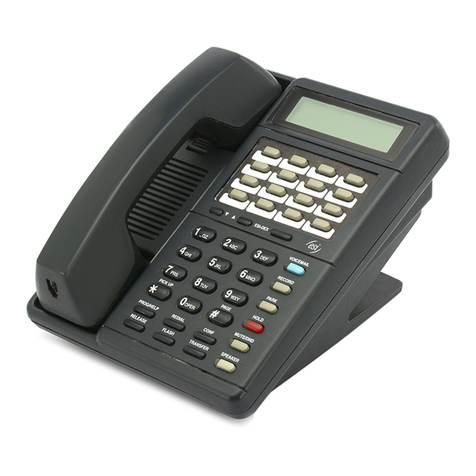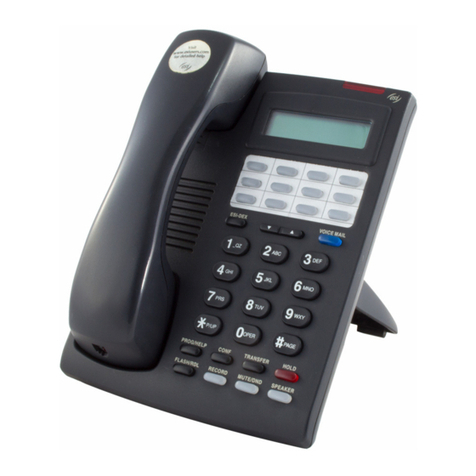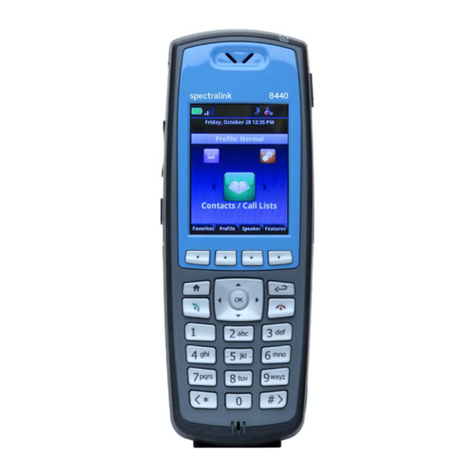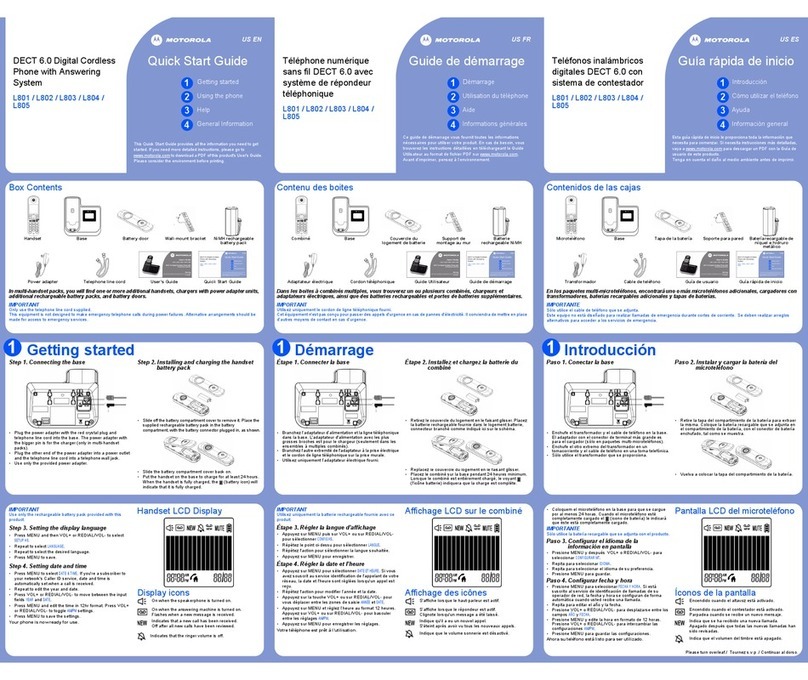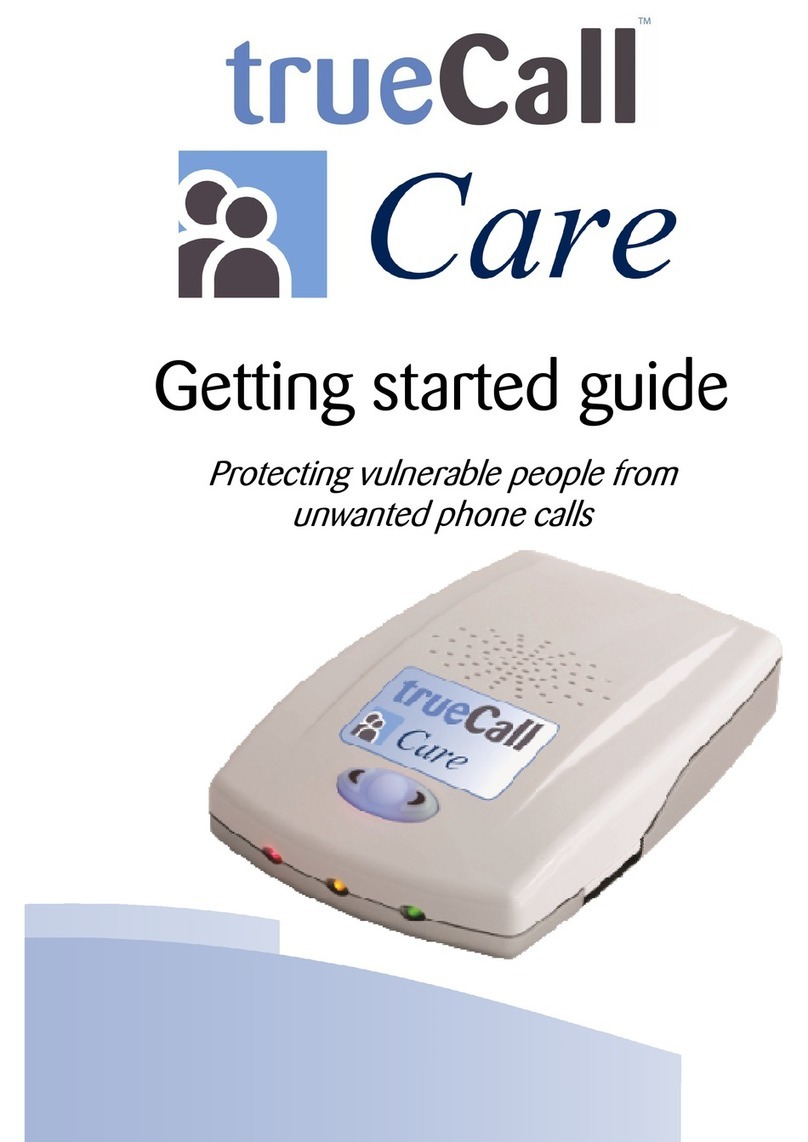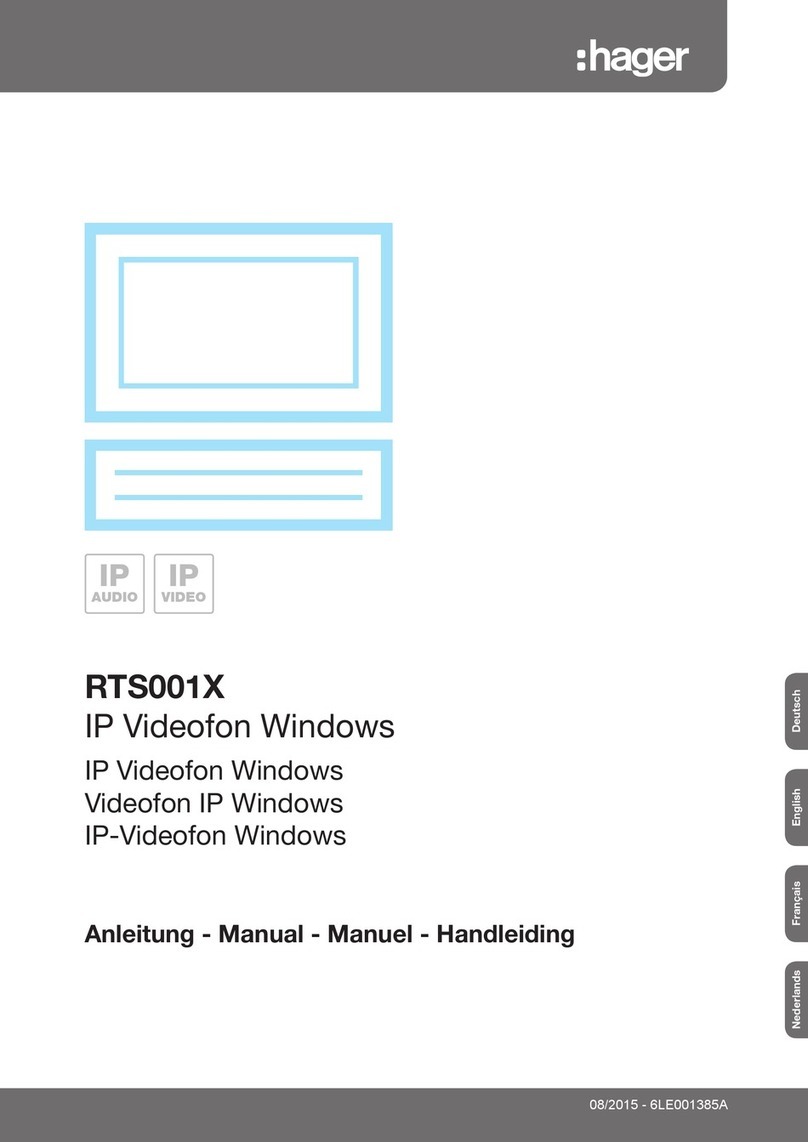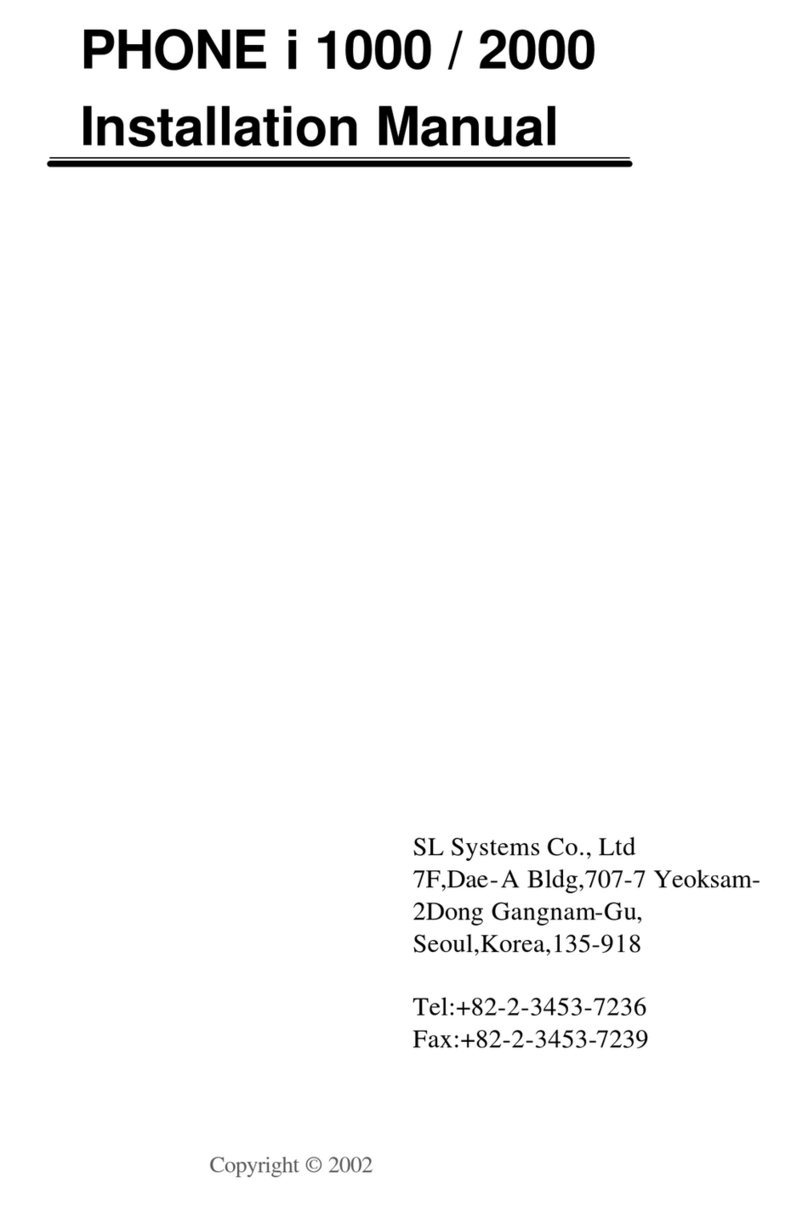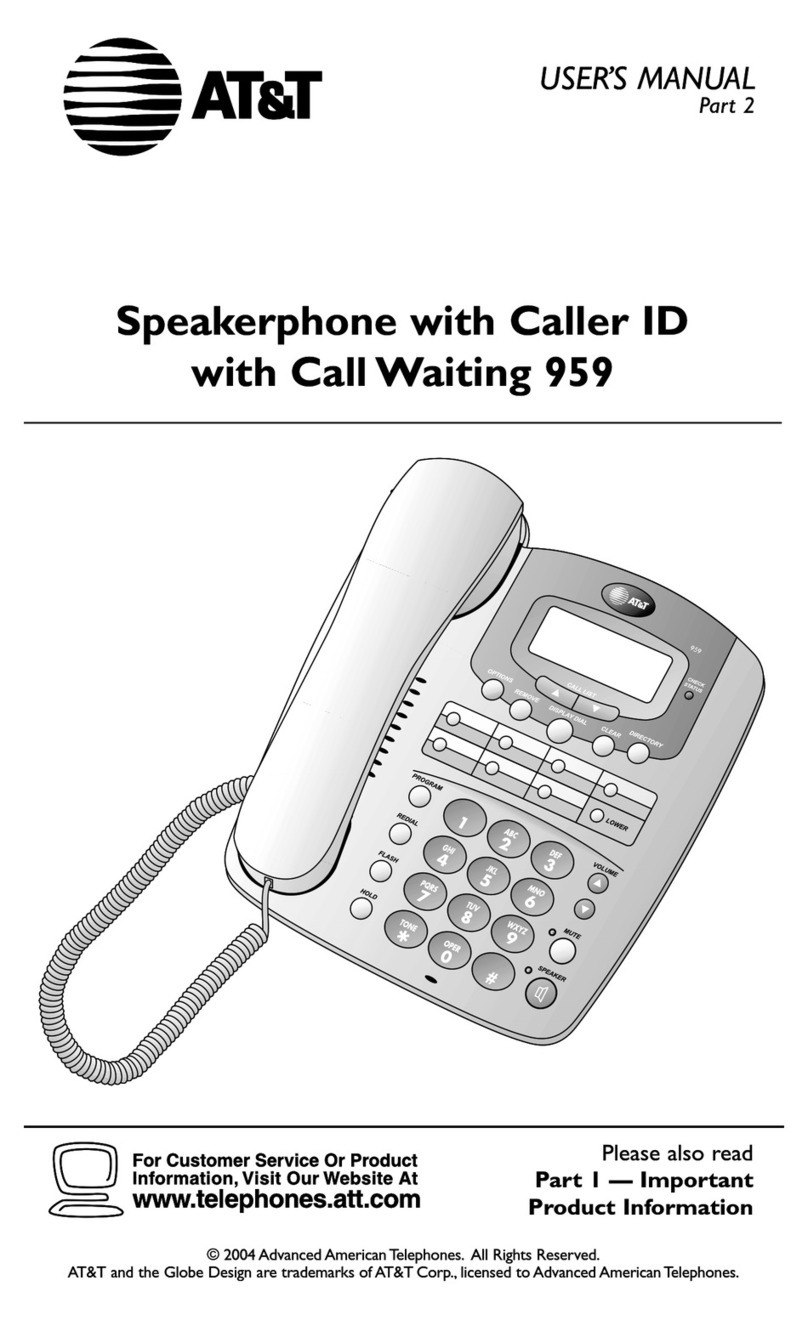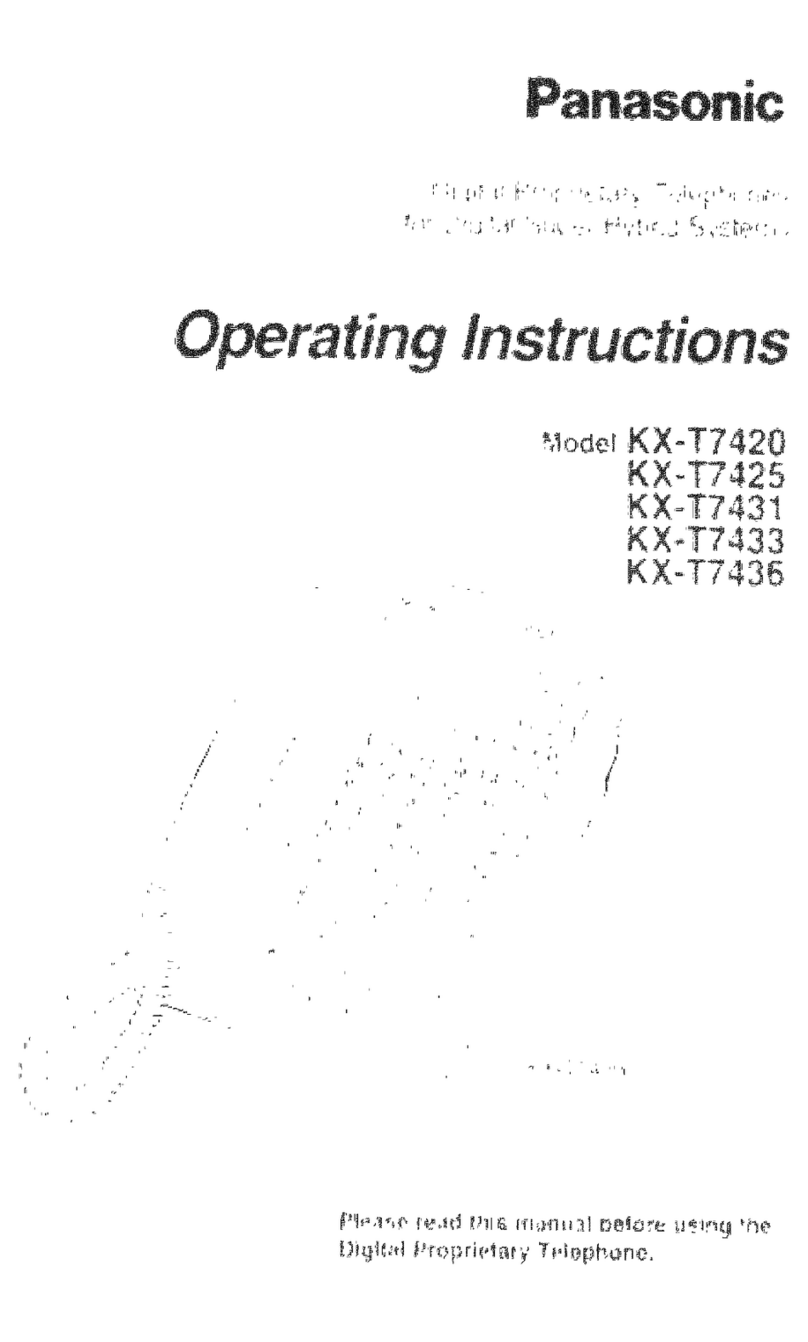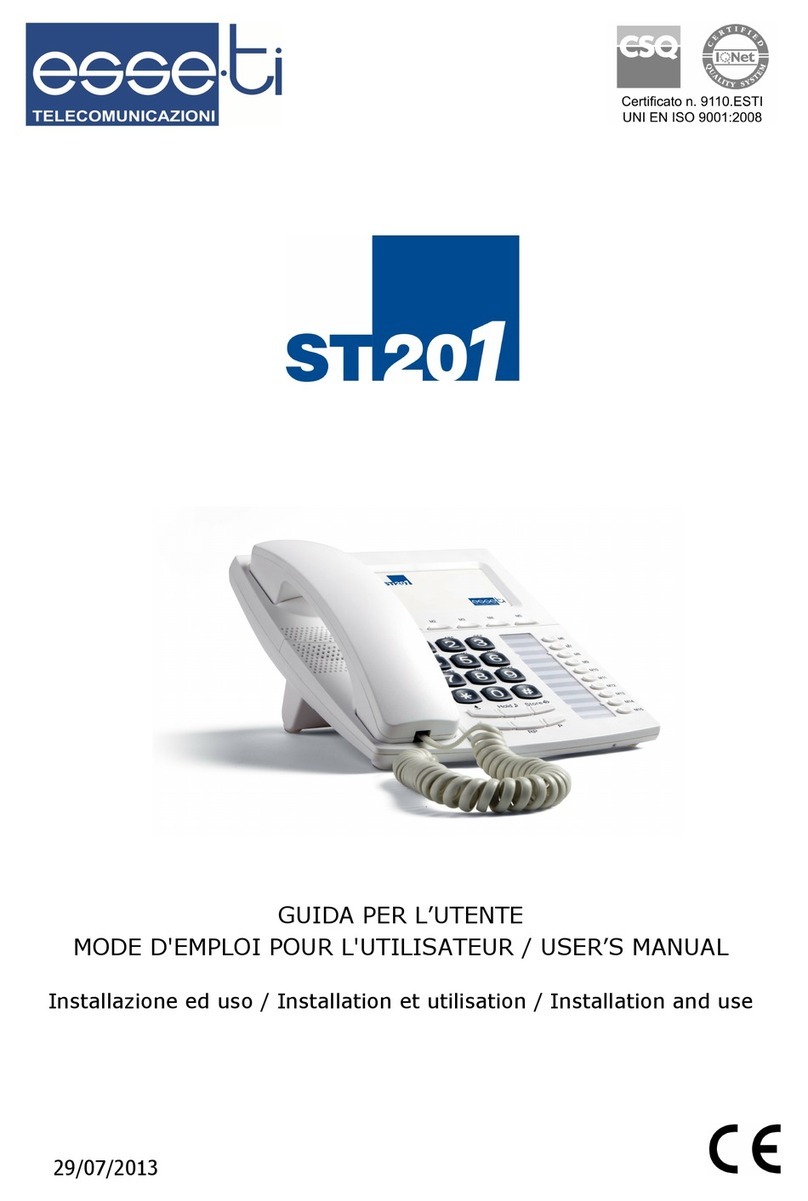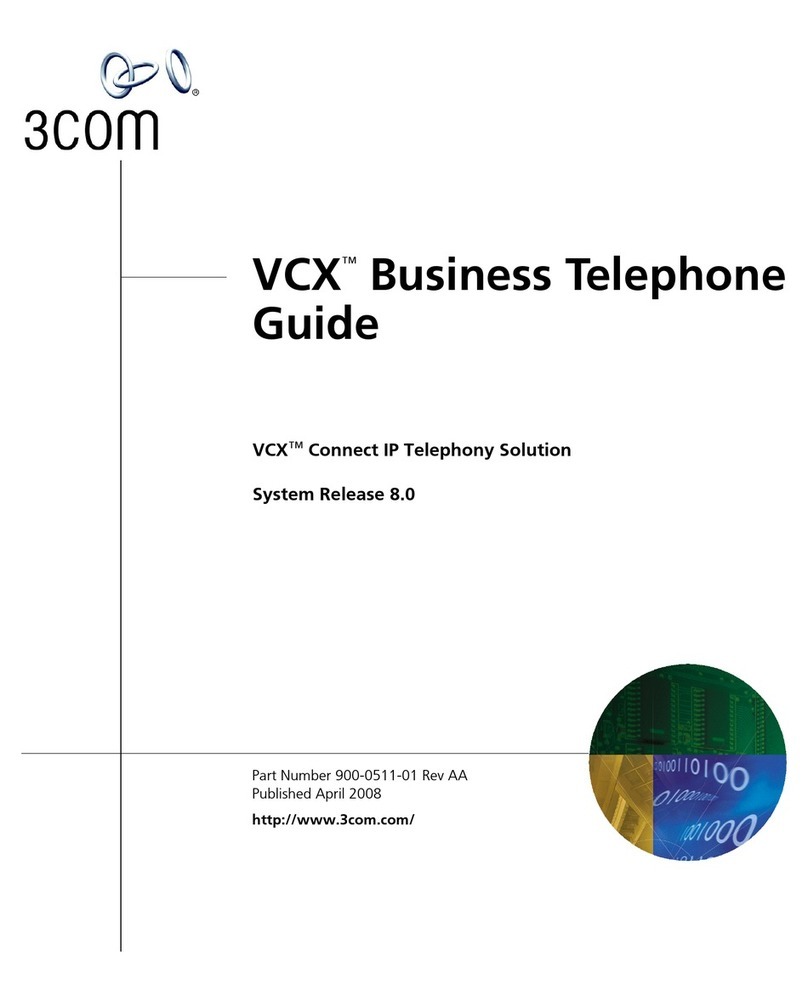ESI IVX S-Class User manual

ESI Feature Phone
User’s Guide
FOR
WITH voice mail
0450-0467
Rev. N
For on-line help, visit www.esiusers.com.

About ESI
ESI (Estech Systems, Inc.) is a privately held corporation based in Plano, Texas, near the internationally
known “Telecom Corridor.” Founded in 1987, ESI designs and builds innovative telecommunications
products for businesses like yours. Because of their powerful combination of value and features,
ESI products are consistently recognized by industry publications and leaders.
Copyright © 2007 ESI (Estech Systems, Inc.).
Visit ESI on the Web at http://www.esi-estech.com.
IVX is a registered trademark of ESI. Microsoft is a registered trademark of Microsoft Corporation. Intel is a registered trademark of IntelCorporation.
Certain ESI products are protected by various U.S. Patents, granted and pending. Product informationcontained herein is subject to change
without notice. ESI is an ISO 9001:2000-certified company.

Table of contents
Introduction...............................................................................................................................................................A.1
48-Key Feature Phone..........................................................................................................................................................A.2
24-Key Feature Phone..........................................................................................................................................................A.4
12-Key Digital Feature Phone ...............................................................................................................................................A.5
ESI Cordless Handsets .........................................................................................................................................................A.6
Connecting your ESI phone...................................................................................................................................................A.7
Help mode (Verbal User’s Guide)...........................................................................................................................B.1
User programming: An introduction......................................................................................................................C.1
User programming menu.......................................................................................................................................................C.1
Voice mail operation................................................................................................................................................D.1
VOICE MAIL key ...................................................................................................................................................................D.1
Personal greetings.................................................................................................................................................................D.1
Leaving messages . . ............................................................................................................................................................D.2
Moving a message ................................................................................................................................................................D.3
Off-premises “reach me”........................................................................................................................................................D.3
Message retrieval..................................................................................................................................................................D.3
Live recording........................................................................................................................................................................D.6
Off-premises message delivery.............................................................................................................................................D.7
Message Recycle Bin (un-delete)..........................................................................................................................................D.8
Status indicator lamp.............................................................................................................................................................D.8
Optional voice mail feature: Guest mailboxes.......................................................................................................................D.8
Optional voice mail feature: Broadcast mailbox (500).........................................................................................................D.10
Optional voice mail feature: Cascade notification mailboxes...............................................................................................D.11
ESI Feature Phone operation..................................................................................................................................E.1
Display...................................................................................................................................................................................E.1
Caller ID.................................................................................................................................................................................E.1
Keys.......................................................................................................................................................................................E.1
Dial tone.................................................................................................................................................................................E.3
Basic phone use....................................................................................................................................................................E.4
Direct station selection...........................................................................................................................................................E.5
Transferring an outside call . . ...............................................................................................................................................E.5
Transferring an internal call . . ..............................................................................................................................................E.7
Conference calling.................................................................................................................................................................E.8
Call forwarding.......................................................................................................................................................................E.9
Call waiting..........................................................................................................................................................................E.11
Hold/exclusive hold operation..............................................................................................................................................E.12
Paging..................................................................................................................................................................................E.14
Call pickup...........................................................................................................................................................................E.14
Optional features .................................................................................................................................................................E.15
Special keys..............................................................................................................................................................F.1
Esi-Dex..................................................................................................................................................................................F.2
Override ring..........................................................................................................................................................................F.9
Message monitor mode (live call screening) .......................................................................................................................F.10
Personal greeting reminder .................................................................................................................................................F.10
Headset operation...............................................................................................................................................................F.10
Outside dial tone preference................................................................................................................................................F.11
Line keys..............................................................................................................................................................................F.11
Optional features .................................................................................................................................................................F.12
Analog stations........................................................................................................................................................ G.1
Caller ID................................................................................................................................................................................ G.1
Placing calls.......................................................................................................................................................................... G.1
Transferring calls.................................................................................................................................................................. G.2
Conference calling................................................................................................................................................................ G.2
Call forwarding...................................................................................................................................................................... G.3
Call waiting........................................................................................................................................................................... G.3
Call hold................................................................................................................................................................................ G.3
Paging................................................................................................................................................................................... G.4
Call pick-up........................................................................................................................................................................... G.4
Voice mail operation from an analog station......................................................................................................................... G.4
Analog station programming................................................................................................................................................. G.7
Index

(This page included for pagination purposes only.)

User’s Guide Introduction
A.1
Introduction
Accessing the rich ESI feature set is simple and easy through the straightforward design of ESI Digital
Feature Phones and the ESI Digital Cordless Handset. Each feature has been designed for ease of use
while providing capabilities needed in an advanced business phone.
You will be able to learn many of the features by simply using your phone; and this IVX S-Class User’s
Guide will introduce you to the wide variety of features offered by your ESI phone system and how to
use your phone effectively to achieve maximum benefits.
What it covers
•48-Key Digital Feature Phone
•24-Key Digital Feature Phone
•12-Key Digital Feature Phone
•ESI Digital Cordless Handset
•60-Key Expansion Console (for use with the 48-Key Digital Feature Phone only)
How it’s arranged
•Section A — Introduction and phone illustrations
•Section B — User help
•Section C — User programming
•Section D — Voice mail operation
•Section E — Phone operation
•Section F — Special keys and features
•Section G — Analog Stations
•Index
Voice mail options
Your IVX S-Class phone system comes with ESI’s award-winning voice mail, including an automated
attendant and a dedicated mailbox for each station.
The automated attendant provides up to 18 branches that conveniently route callers to their desired
extensions or departments, or even destinations outside the system.
Some features are enabled by the Installer or System Administrator. Consult your System Administrator
if you are unsure about what S-Class features are available.

Introduction User’s Guide
A.2
48-Key Feature Phone
The 48-Key Feature Phone has a variety of programmable and built-in features. It comes in two
versions: Digital and TAPI. Additionally, it supports the optional 60-Key Expansion Console. Both
versions of the 48-Key Feature Phone offer the same basic features that are described throughout this
User’s Guide. The 48-Key Feature Phone’s built-in voice mail features and voice prompts make it easy
to program and use.
Status indicator
lamp (pg. D.8) 3-line, 56-character display
Volume/scroll keys
PROGRAM
soft feature key
(pg. C.2)
ESI-DEX
soft feature key
(pg. F.2)
HELP key fo
r
access to Verba
l
User Guide
and tutoria
l
(pg. B.1)
Context-specific
key to select
displayed options
VOICE MAIL
key (pg. D.1)
Speaker
RECORD key
(pg. D.6)
P/UP (pickup) key
(pg. E.14)
30 programmable
feature keys
(pg. C.2)
PAGE key
(pg. E.14)
Fixed feature keys
(pg. E.1) Microphone for
built-in speakerphone
Hint: You can perform direct programming by holding down a programmable feature key for at least two
seconds (similar to how you might program a car radio button). This isn’t applicable to the fixed-feature
keys which, as their name implies, are already programmed.

User’s Guide Introduction
A.3
Optional 60-Key Expansion Console for use with the 48-Key Feature Phone
The 60-Key Expansion Console adds 60 more programmable feature keys to your 48-Key Digital
Feature Phone.
You program the Expansion Console’s keys just as you do the programmable feature keys on your ESI
Feature Phone, using either direct or traditional programming (see pages C.2).
Note: Only one key can exist perextension, feature or operation. If you program a second key for the same
extension, feature or operation, this automatically erases the first key so programmed, thus making it
available for a new extension, feature or operation.
Hint: You may find iteasier to write in the names on the overlay before you program the keys and attach the
overlay to the Console.
60 programmable
feature keys
(pg. C.2)
in two banks
of 30 each
Hint: You can perform direct programming by holding down a programmable feature key for at least two
seconds (similar to how you might program a car radio button). This isn’t applicable to the fixed-feature
keys which, as their name implies, are already programmed.

Introduction User’s Guide
A.4
24-Key Feature Phone
The 24-Key Feature Phone has a variety of programmable and built-in features. The 24-Key Feature
Phone’s built-in voice mail features and voice prompts make it easy to program and use.
Volume/scroll keys Status indicator
lamp (pg. D.8)
ESI-DEX key (pg. F.2)
2-line, 32-character display
Speaker
12 programmable
feature keys (p. C.2)
P/UP (pickup) key
(pg. E.14)
VOICE MAIL key (pg. D.1)
PROG/HELP combo key
for phone programming
(pg. C.2) and access to
Verbal User Guide
and tutorial (pg. B.1)
PAGE key (pg. E.14)
RECORD key (pg. D.6)
Microphone for
built-in speakerphone
Other fixed feature keys
(pg. E.1)
Hint: You can perform direct programming by holding down a programmable feature key for at least two
seconds (similar to how you might program a car radio button). This isn’t applicable to the fixed-feature
keys which, as their name implies, are already programmed.

User’s Guide Introduction
A.5
12-Key Digital Feature Phone
The 12-Key Digital Feature Phone includes the basic, most commonly used phone features.
Volume/scroll keys
1-line,
16-character display
Speaker
9 programmable
feature keys (pg. C.2)
P/UP (pickup) key (pg. E.14)
PAGE key (pg. E.14)
PROG/HELP combo key
for phone programming
(pg. C.2) and access to
Verbal User Guide
and tutorial (pg. B.1)
Fixed feature keys
(pg. E.1)
Notes: The following features are not available on the 12-Key Digital Feature Phone.
• Certain special features (see page F.12).
• Esi-Dex.
• Speakerphone.
A VOICE MAIL key, CONFERENCE key, and MUTE/DND key must be set on one of the nine
programmable feature keys to utilize those features.
Hint: You can perform direct programming by holding down a programmable feature key for at least two
seconds (similar to how you might program a car radio button). This isn’t applicable to the fixed-feature
keys which, as their name implies, are already programmed.

Introduction User’s Guide
A.6
ESI Cordless Handsets
ESI’s Digital Cordless Handsets come in two models — small and large — but each offers the same
features. Note that they do not have the following features found on some ESI desktop phones:
speakerphone, Esi-Dex support (or ESI-DEX key), Caller ID key, Virtual Mailbox Key support, or Verbal
User Guide (or HELP key). Each model comes with a charger/AC adapter, base station, belt clip,
battery pack, and wall mount.
Two-line, 32-character display;
third line contains status icons
VOICE MAIL key (pg. D.1)
Other fixed feature keys (pg. E.1)
CHANNEL key
TALK key
Four programmable feature keys (pg. C.2)
Compact model Heavy-duty model

User’s Guide Introduction
A.7
Connecting your ESI phone
Use the diagram (below) to connect your ESI phone. The diagram represents the panel on the
phone’s underside.
Note: The “Top of phone” and “Bottom of phone” references in this diagram shows the correct vertical
orientation of the phone — i.e., the part with the display is the top.
12-Key Feature Phone
24-Key Feature Phone
•Connects like a basic phone.
•Handset plugs into right-side jack.
•Line cord plugs into left-side jack.
48-Key Digital Feature Phone
In addition to how the 24-Key Feature Phone connects
to the handset and line cord, note the following:
•TAPI version includes a cable for connecting to your
PC’s serial port.
•60-Key Expansion Console cable (included with each
Console) uses standard RJ-11 telephone connectors.
Note: Use the wall mount hook (located under the handset) when the phone is in the furthest upright position.
Line cord
to wall
Handset
Connectors on bottom of
48-Key DigitalFeature Phone
(headset jack shown)
Line cord
to wall
To 60-Key
Console Handset
(TAPI)
to PC
To
headset

Introduction User’s Guide
A.8
60-Key Expansion Console connection
Notes: The 60-Key Expansion Console can be connected to only a 48-Key Feature Phone.
1. The 60-Key Expansion Console (right) includes an expansion cable.
Connect one end of the expansion cable to the appropriate connector
on the bottom of the Feature Phone (below).
Then, connect the other end of the expansion cable to the 60-Key
Expansion Console.
2. To keep cabling out of the way, thread the expansion cable into the
slots on the bottom of the phone and 60-Key Expansion Console.
3. Program the keys on the 60-Key Expansion Console using the same
procedure as with the Digital Feature Phone (press PROGRAM 2).
4. If necessary, remove the clear plastic overlay from the keys on the
Expansion Console.
5. For maximum convenience, label the paper overlay to show how
the keys are programmed (your Installer or System Administrator can do this with ESI software).
6. Install the labeled paper overlay on the 60-Key Expansion Console.
7. Install the clear plastic overlay over the paper overlay, to protect it.
8. Use the provided Velcro®tape to attach the left side of the 60-Key Expansion Console to the right
side of the 48-Key Feature Phone.
Connectors on bottom of
48-Key DigitalFeature Phone
(headset jack shown)
Line cord
to wall
To 60-Key
Console Handset
(TAPI)
to PC
To
headset

User’s Guide Introduction
A.9
ESI Cordless Handset connection
Each ESI Cordless Handset comes with:
•A charger/cradle to charge the Handset.
•An AC adapter for use with only the charger.
•A base station to provide a digital interface between the ESI phone system and ESI Cordless
Handset. This base station is line-powered and thus needs no AC power.
•Wall-mount(s), a belt clip, and a Quick Reference Guide.
Base station installation
Due to each site’s unique characteristics, the range and distance information we’ll provide herein is
only approximate.
Characteristics that positively affect performance:
•The base station should be installed so it has a clear line-of-sight with the Cordless Handset.
•The base station antenna should always be pointed in its uppermost vertical position.
Don’t install the base station:
•Close to a wall, especially one with metal studs.
•Next to a device that emits RFI1or EMI2— e.g., a television, radio, computer, computer printer,
flourescent light fixture, or fax machine.
•Next to any other 900 MHz device — e.g., a hand-held inventory control device.
•In a ceiling that has foil-backed insulation.
•Behind doors that typically are closed, tinted windows, one-way glass, or other areas that limit or
cut off transmission to the Cordless Handset.
Base stations must be installed at least 10 feet apart, regardless of whether the base station is for the
small-model or large-model Cordless Handset. Don’t install more then six base stations in one area
(such as a network room). Choose a location at least 30 feet away if more than six base stations are
needed in a building. Abase station requires only a line cord to the phone system;AC power isn’t
needed because the base station receives power from the phone system via the line cord.
Once the base stations are installed and the Cordless Handsets charged, change each Handset’s
channel by pressing its CH key. Each Handset should have its own channel. There are 30 available
channels on the small Cordless Handset and 10 on the large Cordless Handset.
Note: Feedback may result if the Cordless Handset is within three inches ofan ESI desktop Feature Phone.
1Radio frequency interference.
2Electromagnetic interference.

Introduction User’s Guide
A.10
(This page included for pagination purposes only.)

User’s Guide Help mode (Verbal User’s Guide)
B.1
Help mode (Verbal User’s Guide)
Your ESI phone system’s Help mode (also called the Verbal User’s Guide) — a carefully conceived
combination of spoken information, display readouts and even key illumination when appropriate — is a
powerful tool to help you learn how to use the system’s many features.
Notes: As explained on page E.1, each of the two smaller Feature Phones, 12-Key and 24-Key, has a combo
PROG/HELP key.
The ESI Cordless Handsets have no access to the Verbal User Guide and, therefore, no HELP key.
Tutorial
When your station is idle, press HELP, and then follow the spoken Help menu to:
• Learn how to use the phone • Hear a description of how any key is used
• Learn how to use voice mail features • Hear a complete tutorial on phone operation
Help during station programming
To hear a detailed description of a function you wish to program, press HELP while programming it.
Help during a call
Press HELP while on a call and this will place the call on hold, whereupon you can use Help mode to
hear a description of the function you wish to perform. When you exit Help mode, you will be
reconnected to the call.
While you are either in Help mode or programming your phone, your station will be temporarily placed in
DND (see “MUTE/DND,” page E.3). Anyone calling your station while you are in DND will be forwarded
to your mailbox (or other destination set by the installer).
Exiting Help mode
To exit Help mode, simply hang up.
Visit www.esiusers.com for up-to-date help.

Help mode (Verbal User’s Guide) User’s Guide
B.2
(This page included for pagination purposes only.)

User’s Guide User programming: An introduction
C.1
User programming: An introduction
Voice prompts will play menu and sub-menu options to access the desired feature. You don't have to wait
for the entire prompt to be played. Therefore, once you’ve become familiar with the prompts (consult
“User programming menu” on the next page), you can quickly set any frequently used feature.
Programming help
During any of the programming steps, press HELP to hear a more detailed description of the feature
and related programming options.
Exiting programming mode
To exit programming mode, simply hang up.
User programming menu
Overview
1 Select personal greeting
1 Record
2 Delete
3 Hear
2 Programmable feature keys
(Station keys, line keys, speed-dial keys, other
feature keys)
3 Station options
1 Call waiting/background announce
2 Personal greeting reminder
3 Headset operation1
4 Outside dial tone preference
5 Hands-free answer
6 Message monitor
7 Power-saving mode2
4 Station audibles
1 Station ring tone
2 Station ring volume
3 Message ring
4 Secondary ring tone
5 Secondary ring volume
5 Password
1 Enter
2 Delete
3 Hear
4 Security level
6 External message notification
1 Delivery options
2 Phone delivery
3 Pager notification
7 Personal Call Routing3
1 Entry settings
2 Exit settings
3 Quiet time settings
9 Un-delete
Note: Background announce and selections 3, 5, and 6 underStation Options are notavailable on the
12-Key Feature Phone. Option 7 is available on only the ESI Cordless Handset.
1Not necessary with Generation II system. If unsure which system you have, consult your System Administration.
2For use with only ESI Cordless Handsets.
3Available only if your phone system is using ESI Presence Management. If you’re not sure whether it is, consult your System
Administrator. For more information about ESI Presence Management, visit www.esi-estech.com/presence.

User programming: An introduction User’s Guide
C.2
1 Select personal greeting
Select the desired greeting — 1, 2 or 3. The system will play the current greeting, followed by
prompts to re-record, delete or hear again — or select the current greeting by pressing #.
1 Record personal greeting
Begin recording at the tone. Press 1to stop. The new personal greeting automatically replaces
the previous greeting.
2 Delete personal greeting
When prompted, press 2again to confirm deletion.
Warning: Your mailbox is disabled if no personal greeting exists. Never delete all of your existing
personal greetings before you record at least one new one.
3 Hear current personal greeting
2 Programmable feature keys
There are two methods for programming of your phone:
• Direct programming — Select the key you want to program, and hold it down for at least two
seconds.This not only initiates programming but also lets you immediately program that specific key.
• Traditional programming — Press PROGRAM. The Verbal User’s Guide will speak to you,
walking you through the full menu, during which you can choose the appropriate option.
Direct programming example:
You wish to set one of the keys to dial a co-worker, whose extension is 105. Hold down the key
for at least two seconds. This automatically puts you in feature key programming. Follow the
prompts to enter 1 0 5. (This has allowed you to skip two steps — pressing PROGRAM and
selecting a menu option — that you’d have had to perform if using traditional programming.)

User’s Guide User programming: An introduction
C.3
How the programmable feature keys can be set
• Line keys — Programming a line number (1 through 12)1into a programmable feature key makes it
a line key, which provides the appropriate lamp information and manual outside-line access.
• Station keys — If the digits entered constitute a three-digit number, the programmable feature
key will become a station key, providing the appropriate lamp information and easy access or
transfer. Three-digit numbers entered can be:
— User extensions (100–139 with
Generation II system, 100–129 with
Generation I system)2
— Cascade mailboxes (520–529)
— Department numbers (290–299) — System speed-dial numbers (600–699)
— Guest/info mailboxes3
• Speed-dial keys — In addition to programming a programmable feature key with a system
speed-dial number, you can create personal speed-dial keys for automatic dialing of frequently
called outside numbers. If you program 9(or 8or 7) plus a phone number, the programmable
feature key becomes a speed-dial key. When you program a speed-dial key, there's no need to
insert a pause after the 9(or 8or 7).The speed-dial number can be up to 24 characters long.
Use the up scroll key () to enter special characters in a dial string.
• Other feature keys — If you enter a feature code, the programmable feature key will serve as
an enable/disable key for that feature. The Installer may have programmed certain stations for
accessing additional features (see “Optional features,” page F.12); consult your System
Administrator to determine your access.
Keys’ LED activity during programming
Key type and LED indication
Mode Station key or
Virtual Mailbox Key
Line key Feature key
or speed-dial key
Currently being programmed and
previously assigned Flashing red Flashing green Flashing amber
Currently being programmed and
previously unassigned Flashing red Flashing red Flashing red
Programming mode — Was assigned or
viewed in current session Blinking red Blinking green Blinking amber
Assigned in a previous programming session
and not yet viewed in current session Solid red Solid green Solid amber
Never assigned and not yet viewed in
current session Off Off Off
Note: Each ESI Cordless Handset has only one LED color — red — with similar blinking rates.
11–16 on IVX S-Class Generation II; 1–12 on IVX S-Class Generation I. If unsure which system you have, consult your System
Administrator.
2If unsure which system you have, consult your System Administrator.
3300–489 on IVX S-Class Generation II with “Generation II • Feature Set II” system software; 300–309 otherwise. If unsure which
system and system software you have, consult your System Administrator or ESI Reseller.

User programming: An introduction User’s Guide
C.4
3 Station options
The station options sub-menu (PROGRAM 3) lets you activate or deactivate several features your
station can provide.At each option sub-menu, 1enables the option and 0disables it. (Each option
listed below is explained elsewhere in this manual, as noted.)
1 Call waiting/background announce
See page E.11 for call waiting and page E.12 for background announce.
Note: Background announce is not available on a 12-Key Feature Phone.
2 Personal greeting reminder
See page F.10.
3 Headset operation
See page F.10.1
Note: Not available on a 12-Key Feature Phone.
4 Outside dial tone preference
See page F.11.
5 Hands-free answer
Note: With an ESI Cordless Handset, use of this feature requires a headset.
See page E.2.
Note: Not available on a 12-Key Feature Phone.
6 Message monitor
See page F.10.
Note: Not available on a 12-Key Feature Phone.
7 Power-saving mode
Note: Applicable to only an ESI Cordless Handset.
Allows you to enable or disable an ESI Cordless Handset’s power-saving mode. Enabling this
mode helps achieve full battery life. However, if full-time status monitoring is required, you can
disable this mode. In power-saving mode, the phone system blocks all status updates2to the
Cordless Handset when the Handset has been idle for 30 seconds. Pressing the Cordless
Handset’s keys or receiving an incoming call on it will discontinue power-saving mode.
Note: When the handset has received no calls or status updates2for five minutes, the Cordless
Handset enters deep-sleep mode. During it, the display is blank and the LEDs don’t light up.
If the system sends any updates to the Cordless Handset, it will discontinue deep-sleep mode.
1Not necessary with Generation II system. If unsure which system you have, consult your System Administration.
2For example: If you have a programmable feature key set as a station key for someone’s extension, the system updates your
Cordless Handset based on that extension’s current status (busy, idle, do-not-disturb, or — with optional ESI Presence
Management — off-premises).
Other manuals for IVX S-Class
4
Table of contents
Other ESI Telephone manuals
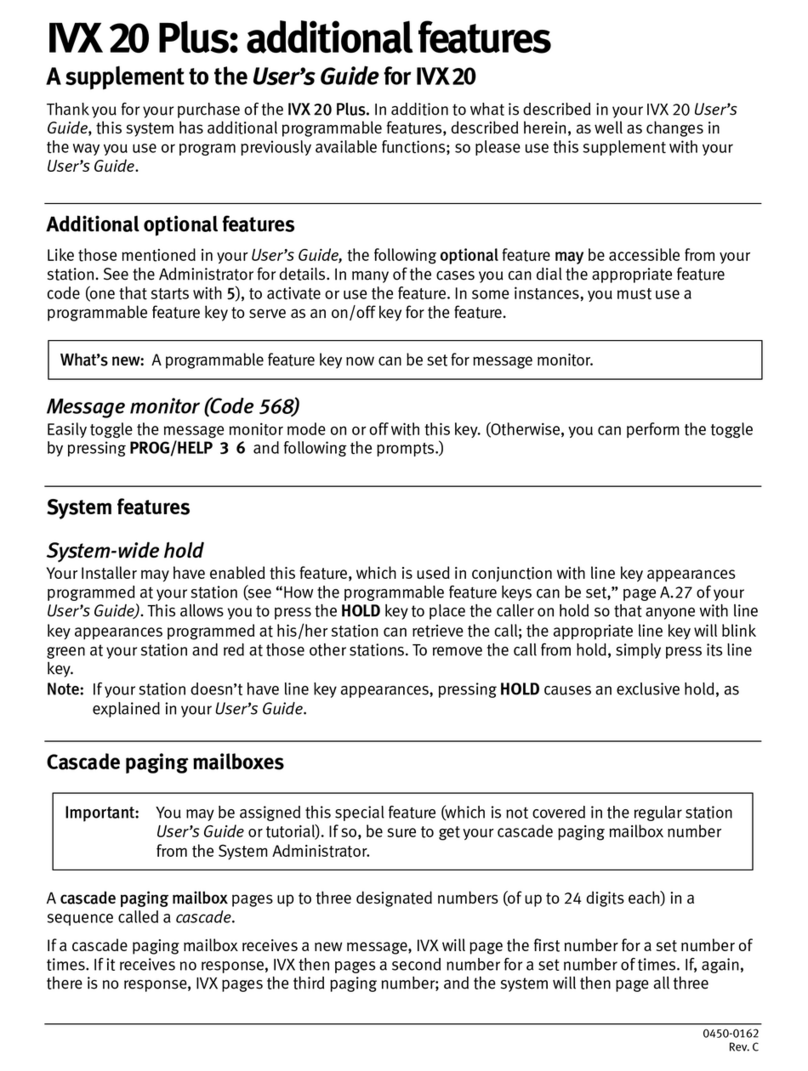
ESI
ESI IVX 20 Plus Owner's manual
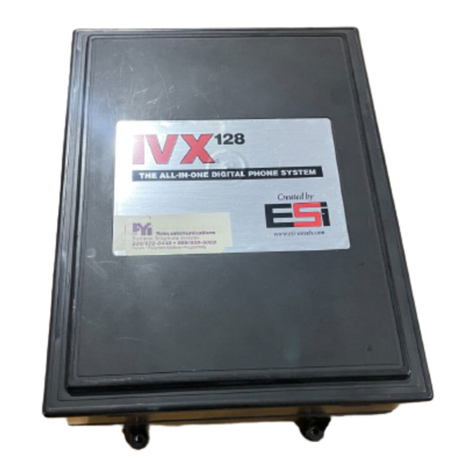
ESI
ESI IVX 128 Plus Installation and operation manual
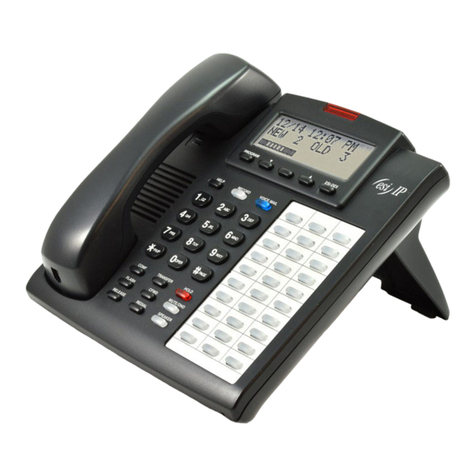
ESI
ESI IVX S-Class User manual
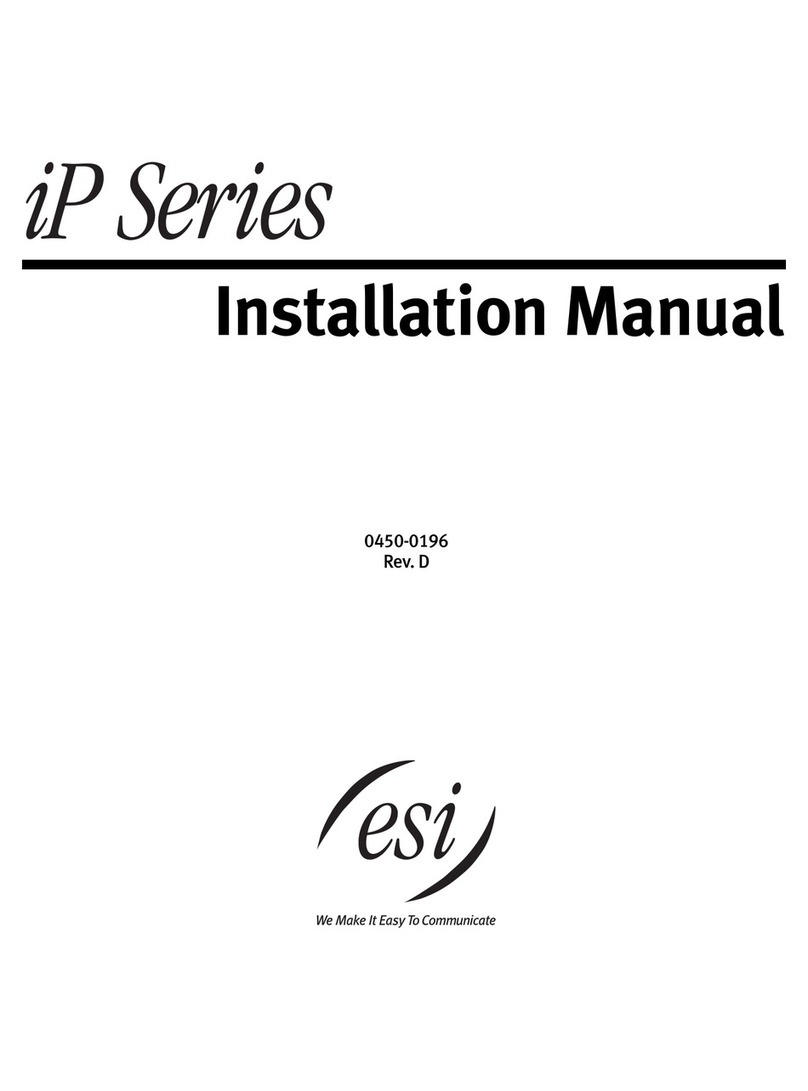
ESI
ESI IP 200 User manual

ESI
ESI IVX S-Class Use and care manual

ESI
ESI 60 Business Phone User manual

ESI
ESI eSIP Evolution Series User manual

ESI
ESI 30D Business Phone User manual
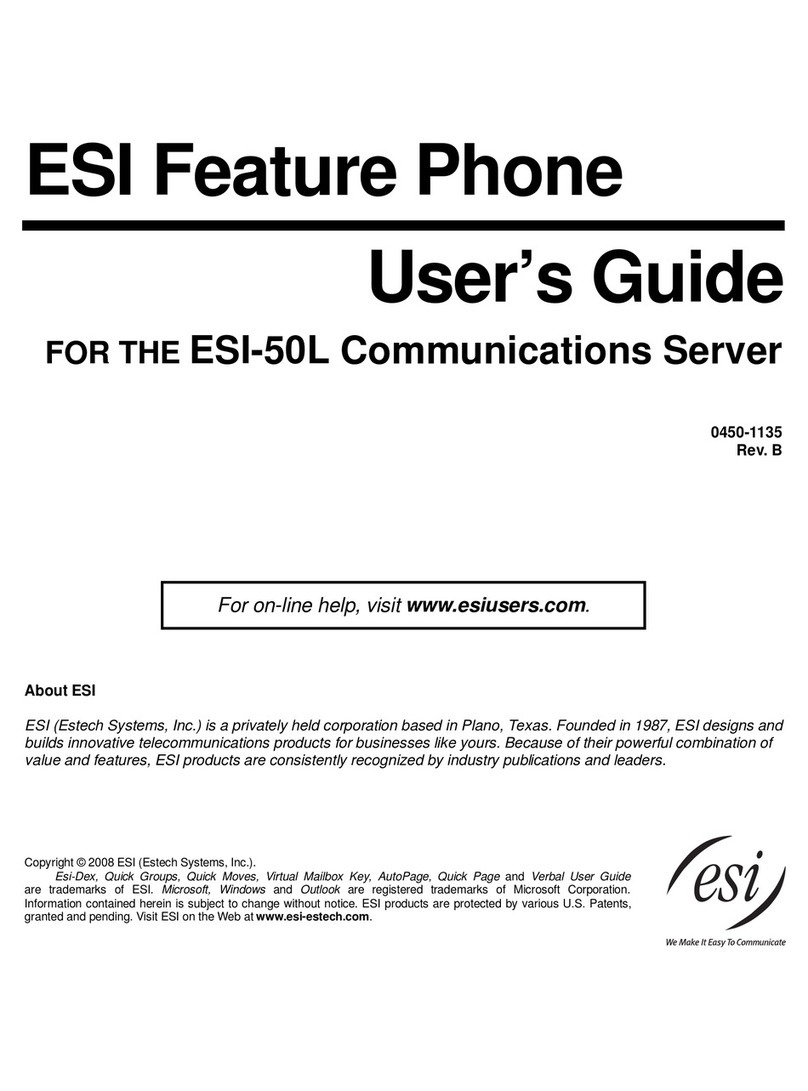
ESI
ESI 50L User manual
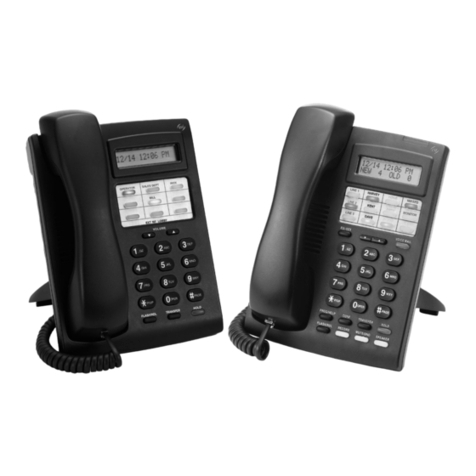
ESI
ESI 12-Key Feature Phone User manual
